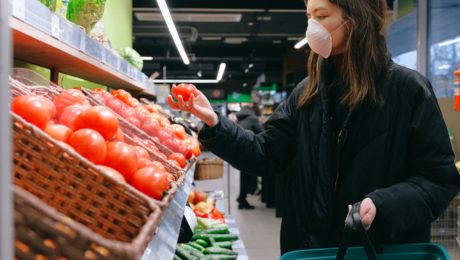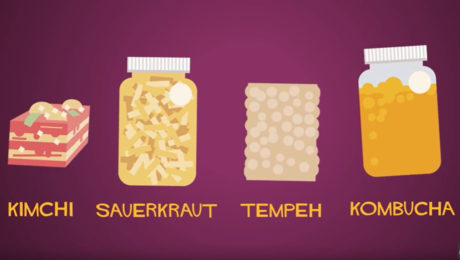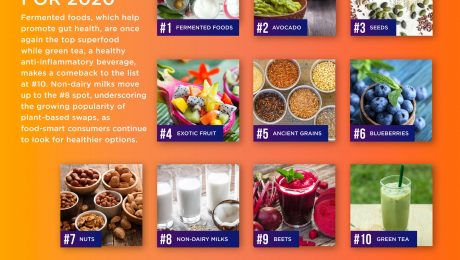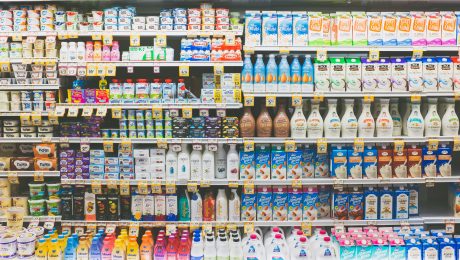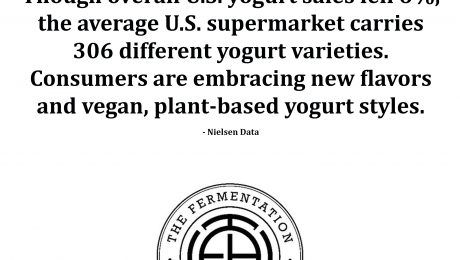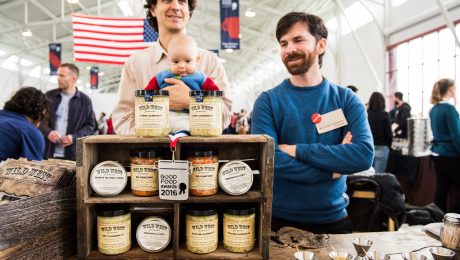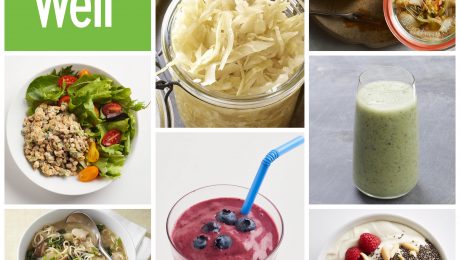Fermentation Booms During Pandemic
In a matter of days, the novel coronavirus outbreak dramatically changed grocery shopping. Empty grocery store shelves have become a ubiquitous symbol globally of home quarantine.
Sales exploded for pantry staples like dried beans (62.9%), powdered milk (126.3%) and rice (57.5%). But another grocery quarantine must-have item is emerging – fermented food and drink. Sales are up for kombucha (10.1%), natto is selling out in Japan, yogurt is selling out in Europe and pickle and sauerkraut sales in Russia are up 79%. Fermentation brands are reporting some of their biggest sales during the month of March, as much of the nation was forced into self-isolation to prevent the spread of COVID-19.
“For fermented food, it’s an interesting time. We’re an immune boosting type of food, so our sales are skyrocketing. We’ve had the best month we’ve ever had in business,” says Drew Anderson, CEO of Cleveland Kitchen and TFA board member. Cleveland Kitchen makes sauerkraut and fermented dressings and marinades. “It is bittersweet. Obviously, we want this virus to go away. But we’re seeing the fermentation industry as a whole, the one benefit is it’s driving a lot of trial. People say ‘I heard fermented food is supposed to be good for you, I’m cooking more, why not grab a pack of kraut.’”
Though sales are high, brands are changing their operation model. Rather than running two shifts of processing at Cleveland Kitchen, they’re down to one. Employees must take daily temperature readings before work, stop for mandatory handwashing breaks and use new Purell hand sanitizing stations.
“Sales are up overall, but we have had to implement our emergency sanitation protocols to continue production,” says Meg Chamberlain, CEO of Fermenti, LLC. The North Carolina-based brand sells a variety of vegetable ferments, teaches fermenting workshops and hosts annual the annual WNC Fermenting Festival. Their staff is under voluntary home quarantine – which means staff only goes from work to home. “Overall our company is proving resilient and we are hopeful to continue to provide Fermenti to our community.”
Because food production is considered essential business, licensed fermentation companies have not been forced to stop working during the coronavirus outbreak.
Aneta Lundquist, CEO of 221 B.C. Kombucha, has been posting videos to her Instagram stories of the Florida based kombucha processing facility. Lundquist says employees are working overtime to deliver orders.
“Our orders during the global pandemic have spiked. Consumers have gone full blown ‘healthy’ food during this health crisis,” she says. “Now is the time to make a switch from over-processed and denaturalized pseudo foods to real, natural and unprocessed foods that nourish our body, mind and spirit and help building a strong immunity.”
Lundquist adds customers need to “think of kombucha, kimchi, sauerkraut and other fermented fruits and vegetables as microbiome rock stars!…Always choose wildly fermented foods.”
“Remember it is about diversity and the quality of microorganisms, not just quantity. You can only achieve this by fermenting traditionally.”
Keenan Smith, CEO of Goodwolf Kefir in Portland, agrees. He says: “The probiotic and fermented space will increase as people have an increase in health awareness and want a better functioning immune system.” They are home delivering their kefir, and donating a
Brands are getting creative with their marketing, too. Goodwolf Kefir is home delivering kefir to the Portland area and donating a proceed of sales to their local food bank. Cultured South and Golda Kombucha have setup a pick-up fridge at their Atlanta location where customers can prepay for an order online, get a secret code to unlock the fridge and grab fermented food and drinks. Wild Kombucha in Baltimore is offering free, local, “no human touch” home delivery for their 12 pack bottles. 28 Mile Vodka & Distillery in Illinois have converted their distillery to make hand sanitizer that they call “Fool’s Gin.” The CEOs of Miyoko’s Creamery and Lifeway Kefir are both using the brands Instagram accounts to share recipes using their product.
Outside the U.S., though, different government rules are restricting fermentation brands from operating during the global outbreak. In India, Mountain Bee Kombucha has halted operations during a 21-day lockdown.
“There is no question that our business is impacted immensely, one for the fact that we are still quite small-scale which supplies directly to a handful of local grocery stores. Currently those grocery stores have been working at limited capacity and/or temporarily shut,” said founder and head brewer Honey Islam. “Another reason for lesser business in these times is due to the lack of awareness in the Indian market about fermented foods, especially kombucha. We are engaged in educating our customers as well as spreading awareness in the community via workshops, classes, 101 sessions, pop-ups, all these channels are education are currently disrupted which stalled our efforts in bringing kombucha awareness to the masses.”
Mountain Bee Kombucha is focusing on educating through Instagram videos and YouTube tutorials.
- Published in Business
How Fermented Food Affects Our Gut
Americans are hearing the term “microbiome” a lot lately. It’s become a common phrase in health food marketing. But the microbiome is still uncharted territory in science.
Dr. Shilpa Ravella, a gastroenterologist and professor of medicine at Columbia University Medical Center, says a large army of trillions of bacteria lives on or in us, and we can alter that bacteria by fueling it with the right (or wrong) foods.
“There are also ways of preparing food that can actually introduce good bacteria, also known as probiotics, into your gut. Fermented foods are teeming with helpful probiotic bacteria, like lactobacillus and bifidobacteria,” Ravella says.
Fermented food and drink are critical to caring for gut bacteria. Because fermented products are minimally processed and provide nutrient-rich variety to diets, she adds.
But that doesn’t mean all fermented products are created equally. Yogurt is a beneficial food, for example, but some brands add too much sugar and not enough beneficial bacteria that the yogurt may not actually help.
Ravella shared her insight in a TedED talk. As the director of Columbia’s Adult Small Bowel Program, she works with patients plagued by gut issues.
“We don’t yet have the blueprint for exactly which good bacteria a robust gut needs, but we do know it’s important for a healthy microbiome to have a variety of bacterial species,” she adds. “Maintaining a good balanced relationship with them is to our advantage.”
Gut bacteria breaks down food the body can’t digest, produces important nutrients, regulates the immune system and protects our bodies from harmful germs.
Though multiple factors affect our microbiome – the environment, medications and even whether or not we were birthed vaginally or through a C-section – the food we eat is one of the most powerful allies for the microbiome.
“Diet is emerging as one of the leading influences on the health of our guts,” Ravella adds. “While we can’t control all these factors, we can manipulate the balance of our microbes by paying attention to what we eat.”
In addition to fermented food and drink, fiber is also key. Dietary fiber in foods like fruit, vegetables, nuts, legumes and whole grain are scientifically proven to colonize the gut.
“While we’re only beginning to understand the vast wilderness inside our guts, we already have a glimpse of how crucial our microbiomes are for digestive health,” Ravella says. “We have the power to fire up the bacteria in our bellies.”
- Published in Food & Flavor, Science
Sales of Probiotic Products Rise
As the coronavirus outbreak continues to put health on the forefront of consumer’s minds, the sales of probiotic products are rising. GlobalData, an analytics company tracking grocery sales, notes that natto (fermented soybeans) were out of stock in Japan consistently since the outbreak. Sales of yogurt are also increasing.
“Consumers are more actively buying probiotic products. There will not be natto panic buying in Europe, but probiotic products claiming to improve the immune system are likely to grab consumers’ eye,” said Mitsue Konishi, senior innovation analyst at GlobalData.
Read more (Food & Drink Technology) (Photo by ABC News)
- Published in Business
Fermented Foods Again Top Superfoods List
For the third year in a row, fermented foods tops Today’s Dietitian list of the year’s No. 1 superfood. The annual “What’s Trending in Nutrition” survey reveals the hottest food and nutrition trends to look for in 2020.
“The 2020 survey results send a clear and consistent message. Consumers want to live healthier lives,” says Louise Pollock, president of Pollock Communications. “They have access to an incredible amount of health information, and they view food as a way to meet their health and wellness goals. Consumers are taking control of their health in ways they never did before, forcing the food industry to evolve and food companies to innovate in response to consumer demand.”
Consumers are using fermented products as “powerhouse foods,” foods that boost gut health and reduce inflammation. Some nutrition experts recommend fermented foods should be included in national dietary recommendations.
In April, Today’s Dietitian published an article “The Facts About Fermented Foods.” In it, Dr. Robert Hutkins, a researcher and professor of food science at the University of Nebraska-Lincoln, shared his expert opinion on fermentation. Hutkins wrote what many in the field consider the most exhaustive textbook on fermentation, “Microbiology and Technology of Fermented Foods.” He explained how fermented foods have a long history in the human diet.
“Indeed, during much of human civilization, a major part of the human diet probably consisted of bread, yogurt, olives, sausages, wine, and other fermentation-derived foods,” Hutkins told Today’s Dietitian. “They can be considered perhaps as our first ‘processed foods.’”
Hutkins, who studies the bacteria in fermented foods, said researchers like himself “are a bit surprised fermented foods suddenly have become trendy.”
“Consumers are now more interested than ever in fermented foods, from ale to yogurt, and all the kimchi and miso in between,” he says. “This interest is presumably driven by all the small/local/craft/artisan manufacturing of fermented foods and beverages, but the health properties these foods are thought to deliver are also a major driving force.”Fermented foods first appeared in the survey of registered dietitian nutritionists (RDNs) in 2017, where it was the 4th most popular superfood.
The full superfoods list includes:
- Fermented foods, like yogurt and kefir
- Avocado
- Seeds
- Exotic fruit, like acai, golden berries
- Ancient grains
- Blueberries
- Nuts
- Non-dairy milk
- Beets
- Green tea
- Published in Food & Flavor, Health
Preventing Chronic Health Conditions with Fermented Dairy
Health and wellness professionals are recommending food and drink to aid chronic health conditions with a centuries-old cooking legacy – fermented dairy.
“Fermentation is back. In fact, we have over 10,000 years of fermentation history and we aren’t done because, right now, it is a hot culinary and nutrition topic,” said Andrew Dole, chef, dietitian and owner of BodyFuelSPN. “Today, fermented foods have found a resurging popularity. The combination is based in the unique taste profile, the artisan aura, and the health benefits that have secured fermented foods in the top spots with trend spotters.”
Dole spoke at the “Get Cultured on Fermented Dairy Foods” webinar with National Dairy Council representatives Sally Cummins and Chris Cifelli. Using independent, clinical studies, the trio highlighted how fermented dairy – especially dairy with the “nutrition powerhouse” of milk – can boost gut health, decrease inflammation and reduce the risk of Type 2 diabetes and cardiovascular disease.
Fermented Food Just as Important as Fiber
Fiber is the shining star of the health world to aid the complex gut microbiome, but fermented food and drink are equally as important said Cifelli, PhD, vice president of Nutrition Research for the National Dairy Council.
“When we think about food, we think about fiber and we know the benefits of fiber in terms of helping our microbiota, but we also don’t think about getting those live and active cultures the same way and we really should,” he said.
The microorganisms that come from fermented foods are just as critical as fiber. He pointed out the Live & Active Culture seal as an important indicator of how to find dairy products with good bacteria. That seal – a voluntary seal by the National Yogurt Association – identifies a yogurt product that contains at least 10 million cultures per gram at the time of manufacturing. Some yogurt brands are heat treated after fermentation, killing any good bacteria. The seal is “the industry validation of the presence and activity of significant levels of live cultures,” according to the National Yogurt Association.
Fermented Dairy as Preventative Food
The human digestive tract contains 100 trillion bacterial cells. But modern practices like sanitation, antibiotics, processed food, c-section births and baby formula use have altered microbiota composition. Cifelli said scientists still don’t understand whether disease is a cause or consequence of an imbalance of good and bad bacteria (known as dysbiosis).
Fermented dairy foods, though, are linked to numerous positive health benefits. As plant-based milk products become increasingly popular, Cifelli noted the research all studied dairy milk products. He called milk “a foundational ingredient in all fermented dairy.” The essential nutrients in milk give it a unique health profile, the reason the Dietary Guidelines for Americans recommend three daily servings of dairy food.
Diabetes and cardiovascular disease – two of the major disease plaguing Americans today – both have beneficial health outcomes when a patient consumes fermented dairy products.
Diabetes:
- American Journal of Clinical Nutrition: Consuming more dairy products reduces risk for Type 2 Diabetes by 7%. Eating 80 grams of yogurt daily compared to 0 grams of yogurt daily reduces risk for Type 2 Diabetes by 14%.
- PLOS One (Public Library of Science): Eating 30 grams of cheese daily and 50 grams of yogurt daily reduces risk of Type 2 Diabetes by 6%.
- BMC Medicine: One serving of yogurt a day is associated with a 17% reduced risk for Type 2 Diabetes.
Cardiovascular disease:
- American Journal of Clinical Nutrition: A high daily intake of regular-fat cheese for 12 weeks did not alter LDL cholesterol levels of metabolic syndrome, both risk marks of cardiovascular disease risk.
- European Journal of Clinical Nutrition: Cheese consumption reduces the risk of: cardiovascular disease by 10%, coronary heart disease by 14% and stroke by 10%.
- Journal of Hypertension: Higher total dairy intake (3-6 servings a day), especially in the form of yogurt (at least 5 servings a week), associated with a lower risk of incidence of high blood pressure in middle-aged and older adult men and women.
- American Journal of Hypertension: Hypertensive men and women who consumed 2 servings per week of yogurt, especially while eating a healthy diet, were at a lower risk for developing cardiovascular disease.
Cifelli called the studies “significant. He added: “there’s been a huge body of evidence looking at dairy guidelines and (diabetes and cardiovascular disease) risk. … We’re really scratching the surface of what (fermented foods) means for health in the long run.”
Incorporating Fermented Foods
Dole, a chef, said you’re “bringing science to the table when it comes to fermented dairy foods.” Fermented foods enhance food by providing an increased concentration of vitamins, adding delicious flavor and increased texture. He shared multiple recipes using yogurt. Yogurt can be used for dip, spread, sauces, dressings, soups and marinade.
“Yogurt is a culinary powerhouse, from a chef’s perspective. We’re always looking for what has the most bang for its buck in versatility, and yogurt is ready-made everything,” he said.
“The (yogurt) fermentation process from a culinary perspective that creates that lactic acid, it works to tenderize meat. Indians have used it in their tandoor for a really long time. Another reason, the sugar caramelizes…and it completely changes the flavor profile and the color. And we get the unique taste of that yogurt tang, it imparts a different balance and depth, which is something home cooks can struggle to get.”
- Published in Health
Could Fermented Dairy Help Save the Failing Dairy Industry?
As the dairy industry declines rapidly – milk sales plummeted by $1.1 billion in 2018 – fermented dairy could help dairy farmers reclaim the grocery aisle.
More Americans are turning to plant-based options, like nut, oat, rice and soy milk. The demand for milk-based alternatives from companies like Miyoko’s Kitchen (vegan, plant-based dairy products) and Perfect Day Foods (oat milk with fermented yeast) are popular with modern consumers.
But sales are not slowing for fermented milk-based products like kefir and Skyr yogurt.
A study from The Nutrition society published in the Cambridge University Press found multiple health benefits of fermented milk drinks like kefir. Fermented dairy improves digestion, produces anti-inflammatory effects, increases colonization of good gut bacteria and stimulates antioxidants, researchers found. Fermented dairy is high in protein, high in live probiotics and improves lactose digestion.
“Consuming fermented dairy can [help] the digestive system because it actually adds more beneficial bacteria to the system,” said Nicole Dynan, a dietitian with gut health expertise. She spoke to Dairy Australia in an article about the power of fermented dairy. “If we put it in simple terms, most of our bacteria live in the large intestine and can assist that existing population of bacteria to balance out the good and bad. Fermented dairy can contain microbiota that make by-products called short-chain fatty acids that can help release anti-inflammatory benefits into the body.”
“Fermented dairy can also represent a precious source of other nutrients and vitamins such as C and E, while balancing out the ‘bad’ bacteria that can lead to common digestive problems such as bloating, diarrhea, pain and gas,” she says.
Dairy Alternatives Full of “Frankenfood”
Today, 19 percent of yogurt varieties are plant-based. Christopher Malnar, vice president of marketing for Stonyfield, says the ingredient lists on dairy-free yogurts are often alarming. They’re highly processed, full of sugar, chemical stabilizers and what he called “frankenfood.” Organic dairy, meanwhile, is a clean ingredient list with no high processing.
Brands can create demand for dairy again by raising awareness, Malnar said. They can educate on the benefits of dairy and organic products.
“How can we be more innovative as an industry?” Malnar said. “We understand where the market is going [but Stonyfield is] staying true to our core in dairy, recognizing that there are some needs out there.” Stonyfield is currently testing a fruit and vegetable pouch.
Malnar spoke at a panel on organic dairy in September during Natural Products Expo East. When educating consumers on dairy, the panel of organic dairy leaders said it’s important to highlight proper animal treatment. Fairlife Dairy recently came under fire after a video was released of employees abusing calves and cows in a processing facility. Tim Joseph, the founding farmer at Maple Hill Creamery, said he thinks brands lose consumers when they educate them with scientific facts “because it’s just too much information.” Animal welfare is a major consumer driver.
“It’s not whether we think it is right or wrong in the end, it’s what the consumer is looking for,” Joseph said. “Animal welfare is I think the next biggest areas consumers are focusing on.”
Not all Milks Are Equal
A major consumer for plant-based milk: new moms. Mothers, many who adopt a healthy, organic lifestyle once they have children, are turning to dairy alternatives because they believe it’s the healthiest option for their child.
“We’re feeling like we have to go back in time and educate on the value of dairy,” said Melissa Hughes, chief mission officer and general counsel for Organic Valley. “It’s not necessarily to say that plant based isn’t the right thing, but especially for a lot of young moms, make the choice based on good science and good understanding of what the nutritional value is for your child.”
American dietary guidelines dictate that, besides water, milk is the only other drink recommended for children.
Jessica Shade, the director of science programs for the Organic Center, presented findings of a study on modern milk in today’s grocery market, comparing organic and conventional milk. The biggest takeaway: Americans should be choosing dairy milk for the nutritional benefits, and organic milk to avoid exposure to harmful chemicals.
Shade said she was surprised testing milk that non-organic varieties test positive for antibiotics, high levels of growth hormones and pesticide contaminants. “…it is much more ubiquitous than previously thought,” Shade added. Many of these are illegal residues are banned by the Food and Drug Administration. They concentrate highly in cow milk, and research shows they can lead to a wide array of health problems in humans. Allergies, hypersensitivity, rashes, headaches, birth defects, hyperthyroidism are all linked to consuming contaminants in milk.
Organic milk, meanwhile, did not test for any illegal residues.
“The findings about conventional milk are really concerning,” Shade said. “That’s the question that needs to be asked and needs to be addressed – how are these chemicals getting into the milk supply when they shouldn’t be there? The difference between organic and conventional are extremely significant…the easy way to avoid all of these residues is by choosing organic.”
The American dairy industry is in a period of oversupply, hurting farmers especially who are forced to throw out milk. On average, it takes three years to transition a dairy farm from conventional to organic.
“The challenge with any dairy, whether it’s organic dairy or conventional dairy, is balancing this perishable product that’s coming out of the cows and making sure you put it into the system as quickly as you can in order to return a value,” said Hughes.
“We’ve seen the slowdown. For Organic Valley, we’ve seen the slowdown of consumption in fluid milk. For us, quality really becomes a very important thing. Volume becomes a very important thing, and how do you control that when most of your volume is folks drinking milk? But at the same time we’ve seen an incredible increase in the consumption of butter. Everyone loves butter and fat. It’s really pushing some pressures on our supply chain to make that all work together. We’re starting to see more opportunity.”
- Published in Business
Average Supermarket Carries 306 Different Yogurt Varieties
Though overall U.S. yogurt sales fell 6%, the average U.S. supermarket carries 306 different yogurt varieties. Consumers are embracing new flavors and vegan, plant-based yogurt styles.
-Nielsen Data
- Published in Business
“Best Yogurt in America” Finally Sold in California, After Being Forced Out of the State
The yogurt Los Angeles Times calls “the best yogurt in America” was forced out of California in 2011. White Moustache, which sells Greek and Persian yogurts with seasonal fruit common in Iranian cuisine added, moved to Brooklyn in 2012 after California Department of Food & Agriculture shut them down. According to California state law, making a milk-based product in a facility separate from the facility where the milk was pasteurized is illegal. Though White Moustache founder Homa Dashtaki produces her famous yogurt in New York, she now sells it in California — Manhattan’s brand of Eataly opened a Los Angeles store, and Dashtaki’s family members oversee production for the West Coast store.
Read more (The Los Angeles Times)
- Published in Business
Deadline for Good Food Awards Extends to Tomorrow
The deadline for the annual Good Food Awards has been extended until tomorrow, August 2. The Good Food Awards invites food producers from across the country to submit their beer, charcuterie, cheese, chocolate, cider, coffee, confections, elixirs, honey, oils, pickles, preserves, preserved fish, spirits, pantry items, snacks and – new this year – grains! (Grains, you ask? We’re talking grits, rice, quinoa tortillas, pasta and more!) Click here to apply.
Award winners from 2019 featured multiple fermented products, like Forward Roots Fermented Vegan Kimchi Sauce, St. Benoit Creamery Plain Yogurt, Elevate Grain Naturally Fermented Beer Grain Crackers, Blue Bus Cultured Local Kraut-chi, Civil Ferments Ethiopian Sauerkraut, Little Apple Treats Original Apple Cider Vinegar, Barrel Creek Provisions Cucmbers, Lindera Farms Apple Cider Vinegar, Gold Mine Natural Food Co Organic Probiotic Golden Kraut, Hex Ferments Sauerkraut, St. Pete Ferments Jackfruit Kimchi, Oly Kraut Local Spicy Garlic Sauerkraut, Real Pickles Organic Garlic Dill Pickles & Organic Garlic Kraut.
Read more (The Good Food Awards) http://bit.ly/2ysMWed
(Photo by: Good Food Awards of 2016 winner, Wild West Ferments)
- Published in Business
Eating Well Publishes 7 Must-Eat Fermented Foods for Healthy Gut
Dietician Lisa Valente writes in Eating Well the seven must-eat fermented foods for a healthy gut. Her list features: sauerkraut, kimchi, kefir, kombucha, miso, tempeh and yogurt. She writes: “Fermented foods are a hot health topic—and for good reasons. These good bacteria—particularly those in our gut—may improve digestion, boost immunity and help us maintain a healthy weight. Research is still emerging on just how important these mighty microbes might be for our health, but the early results are promising. Take care of your gut, and in turn, it will take help take care of you.”
Read more (Eating Well)
- Published in Health

